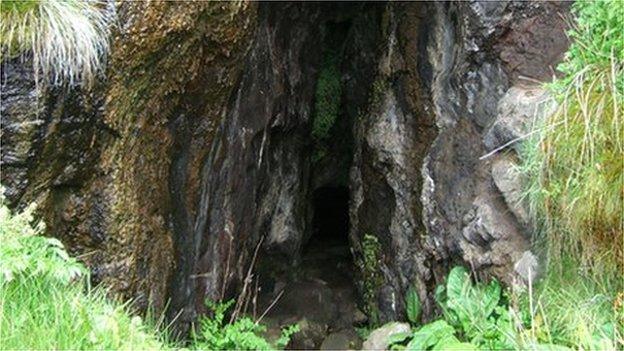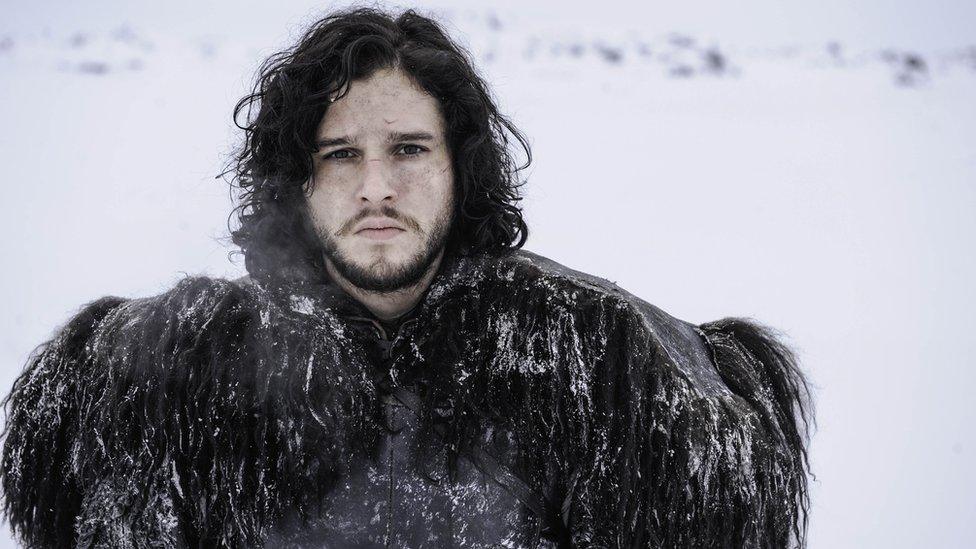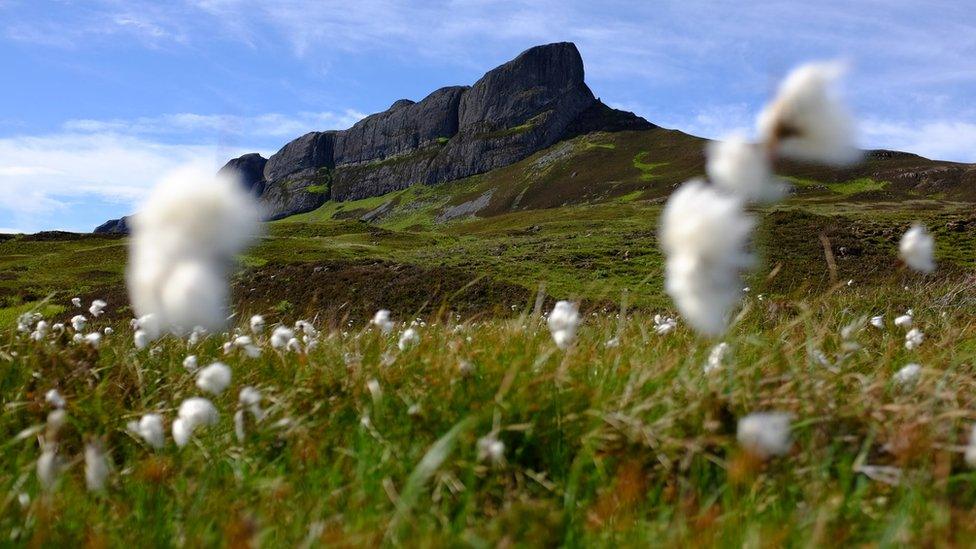Bones linked to Scotland's Eigg Massacre
- Published

The entrance to Eigg's Massacre Cave
Bones discovered in a cave on Eigg have been linked to a massacre of almost the entire island's population during a clan feud in the 16th Century.
More than 50 bones were found after tourists found some of the remains in the isle's Massacre Cave last year.
Analysis by archaeologists at Historic Environment Scotland has dated the remains to the time of the killings.
About 400 islanders, who were members of the Macdonald clan, were murdered by a raiding party of Macleods from Skye.
The islanders had been hiding in the cave for three days when they were discovered.
Macleods blocked the narrow entrance to their hideout with heather and other vegetation before setting the material alight.
The Macdonalds were suffocated by smoke and their bodies left in the cave.
It is believed that the massacre happened in or around the year 1577.

Isle of Eigg or Game of Thrones?

Can you spot stories about Eigg from a plotline in Game of Thrones
The history and legends of Eigg in the Small Isles can at times read like George R R Martin's popular Game of Thrones fantasy series, or TV adaptation of his books.
Like Martin's tales, the island has stories of giants and episodes of bloody violence.
In 617AD, Christian pilgrim St Donnan was beheaded and his fellow monks murdered.
Legend tells of the killings were carried out by large female warriors who lived on the Sgurr, volcanic outcrop that dominates the skyline on Eigg.
Then in the 16th Century, there was the tit for tat violence of the Macdonald-Macleod clans feud.
It saw a chieftain's son beaten and left for dead in a small boat that is said to have drifted back to his home in Skye.
His father, Macleod of Dunvegan, swore to avenge this act, leading to the Eigg Massacre in a secluded cave.

Over following centuries, various parts of skeletons were taken away by souvenir hunters before the authorities later intervened at the request of islanders and all remains that could be found were interred in Eigg's graveyard.
But tourists visiting the cave in October found a number of bones. Archaeologists went on to recover a total of 53 bones.
Camille Dressler, a historian on Eigg, believes the new discovery may have followed a natural disturbance of soil which revealed the remains.
She hopes the bones, which are also to eventually be interred in the isle's graveyard, will stimulate new research of the massacre and the history around it.
She told BBC Radio Scotland that the killings happened during a long standing dispute between the Macdonalds of Clanranald and the Macleods of Dunvegan on Skye.
Hostilities were escalated by the arrival of a party of Macleods on a small island off Eigg during a storm.

Islanders on Eigg were feuding with a clan on Skye
Ms Dressler said: "They helped themselves to cattle and perhaps molested some of the girls looking after the cattle.
"So a party of Eigg Macdonalds crossed over to the island and dispatched the Macleods, reserving the worst fate for the first son of the chief of Macleod of Dunvegan by breaking his limbs and putting him adrift in a little boat without oars, condemning him to a slow and painful death.
"It is said he drifted all the way back to Dunvegan and the chief swore he would have his revenge on the people of Eigg."
A fleet of warriors was sent out from Skye but their galleys were spotted by a watchman on Eigg and the islanders fled the cave.
Its entrance was said to be hidden behind a waterfall.
When the raiders landed they only found an elderly woman who told them nothing of her fellow islanders' hiding place, said Ms Dressler.
Searches for the rest of the residents proved fruitless and the Macleods destroyed the Macdonalds' homes before setting off back to Skye.
It had started snowing and shortly after returning to sea the raiders spotted an islander, who had been sent out from the cave to check if the Macleods had left, against a snow-covered cliff face.
Ms Dressler said: "The Macleods immediately landed back on Eigg and followed the islander's foot prints in the snow to the cave."
The waterfall was diverted and the cave's entrance blocked with flammable material.
Mould-covered skulls
Ms Dressler said: "Macleod of Dunvegan hesitated at the last moment and decided the Macdonald's fate should be left to the judgement of God.
"If the wind blew inland from the sea he would have the material lit. If the wind blew from the land to the sea, it would not."
The wind blew in from the sea.
The remains of the massacred Macdonalds were found for years afterwards.
Hugh Miller, a 19th Century geologist, described seeing skulls covered in green mould and writer Sir Walter Scott also visited the Massacre Cave.
Victorian tourists took pieces of bones as souvenirs before all the remaining bones that could be found were buried in Eigg's graveyard at the request of concerned islanders.
Ms Dressler believes last year's discovery may have followed a natural disturbance of soil which revealed the bones to the modern day tourists.
She added: "Some people don't like to go into the cave because of the narrow entrance and they reflect on this as the place where so many people perished."
Related topics
- Published6 July 2016
